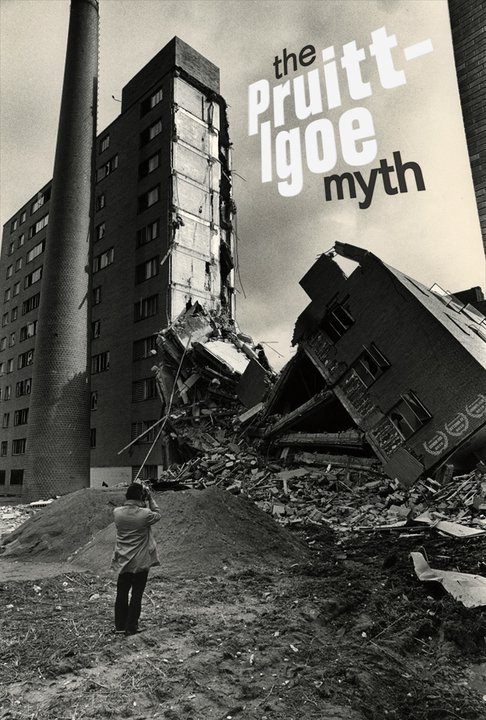 The Pruitt-Igoe Myth, a documentary by Chad Freidrichs, comprises yet another attempt to interpret the history of Pruitt-Igoe, a vast and ambitious St. Louis public housing project by Detroit architect Minoru Yamasaki that was completed in 1956 and failed sixteen years later. By the late 1950s, the quality of life of Pruitt-Igoe’s residents had already begun a catastrophic downward spiral as the buildings fell victim to vandalism and disrepair and became a haven for crime and violence. The complex was demolished in the early 1970s.
The Pruitt-Igoe Myth, a documentary by Chad Freidrichs, comprises yet another attempt to interpret the history of Pruitt-Igoe, a vast and ambitious St. Louis public housing project by Detroit architect Minoru Yamasaki that was completed in 1956 and failed sixteen years later. By the late 1950s, the quality of life of Pruitt-Igoe’s residents had already begun a catastrophic downward spiral as the buildings fell victim to vandalism and disrepair and became a haven for crime and violence. The complex was demolished in the early 1970s.
The demise of Pruitt-Igoe has traditionally been understood primarily, or even purely, as an architectural failing. Architects Journal called it “the modern movement’s most grandiloquent failure” and Charles Jencks famously remarked that “Modern architecture died” the day Pruitt-Igoe’s demolition commenced in 1972. Innovative features — such as elevators that stopped only one floor out of three to serve multi-story “galleries” — were intended to create inviting public spaces and encourage a sense of community on one hand while keeping the project within near-impossible budgetary constraints on the other. Instead, residents found themselves isolated and marginalized in a complex of 33 massive, identical, high-rise buildings. In part, Yamasaki’s monument to the International Style inspired Oscar Newman to develop his theory of “defensible space” which, according to Newman, the Pruitt-Igoe design severely lacked.
Katherine G. Bristol, in her 1991 paper The Pruitt-Igoe Myth (which inspired the Freidrichs film with which it now shares a name) challenges the Pruitt-Igoe-as-design-failure model that has, by now, been taught to a generation of architecture students around the world. Bristol cites a number of economic, political, and social factors that led to Pruitt-Igoe’s demise. In particular, she highlights an ambivalent public policy that subsidized slum clearance and urban sprawl and concentrated low-income housing yet, at the same time, made no provision for the maintenance of even the most basic services to residents of public housing.
Frederichs’s film, surprisingly, makes no reference to the “myth” as identified by Bristol; neither does it attempt to evaluate or criticize Yamasaki’s design. Instead, The Pruitt-Igoe Myth (the film) picks up where Bristol leaves off and tells a story that is striking not for its uniqueness, but for its familiarity. Stripped of the the traditional scapegoats of architecture and design, Pruitt-Igoe’s story of urban disinvestment reveals itself as one that could have happened anywhere — or rather, did happen, in one form or another, in cities all over the United States during the second half of the twentieth century. Once we abandon the notion of architecture-as-cause, we must also let go of the idea of architect-as-savior, forcing us to address the institutional and systemic factors that define our nation’s persistent challenges with respect to quality and affordable urban housing.
The Pruitt-Igoe Myth will be showing at Detroit’s Cass City Cinema on April 19, 20, and 21 at 7:00 and 9:15, and on April 22 at 5:15.









Pingback: Now Playing “The Pruitt-Igoe Myth” | M I C H I G A N M O D E R N
I especially like your balanced reasoning that architecture can neither serve as a savior nor the scapegoat–the factors that brought about Pruitt-Igoe’s abysmal conditions are far more complex than the simple form/configuration of the dwellings. After all, the St. Thomas housing projects in New Orleans were a crime-ridden disaster despite falling into a low-rise typology much closer to our suburban complexes still being constructed routinely to this day. And St. Thomas would have met quite a few of Newman’s standards as good defensible space.
I, too, have long been fascinated/obsessed with Pruitt-Igoe, and perhaps it should be amazing that 98% of it remains undeveloped woodlands to this day. Or maybe–given how market conditions have always overwhelmingly favored St. Louis’ south side over the north–it’s not amazing at all.